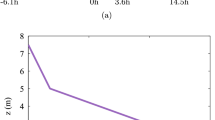Abstract
Momentum and turbulent kinetic energy (TKE) budgets across a forest edge have been investigated using large-eddy simulation (LES). Edge effects are observed in the rapid variation of a number of budget terms across this vegetation transition. The enhanced drag force at the forest edge is largely balanced by the pressure gradient force and by streamwise advection of upstream momentum, while vertical turbulent diffusion is relatively insignificant. For variance and TKE budgets, the most important processes at the forest edge are production due to the convergence (or divergence) of the mean flow, streamwise advection, pressure diffusion and enhanced dissipation by canopy drag. Turbulent diffusion, pressure redistribution and vertical shear production, which are characteristic processes in homogeneous canopy flow, are less important at the forest transition. We demonstrate that, in the equilibrated canopy flow, a substantial amount of TKE produced in the streamwise direction by the vertical shear of the mean flow is redistributed in the vertical direction by pressure fluctuations. This redistribution process occurs in the upper canopy layers. Part of the TKE in the vertical velocity component is transferred by turbulent and pressure diffusion to the lower canopy levels, where pressure redistribution takes place again and feeds TKE back to the streamwise direction. In this TKE cycle, the primary source terms are vertical shear production for streamwise velocity variance and pressure redistribution for vertical velocity variance. The evolution of these primary source terms downwind of the forest edge largely controls the adjustment rates of velocity variances.
Similar content being viewed by others
Abbreviations
- − (overbar):
-
mean quantities or averaging operation
- ′ (single prime):
-
departures from mean quantities
- u,v, w or u 1, u 2, u 3 :
-
components of resolved scale velocity in streamwise (x or x 1), spanwise (y or x 2) and vertical (z or x 3) directions, respectively
- ρ0 :
-
air density
- p :
-
resolved scale static pressure
- h :
-
canopy or tree height
- u * :
-
friction velocity
- F d :
-
canopy drag force
- τ ij :
-
subgrid-scale stresses
- C d :
-
element drag coefficient
- a :
-
leaf area density
- V :
-
wind speed
- δ ij :
-
Kronecker delta
References
Antonia RA, Luxton RE (1971) The response of a turbulent boundary layer to a step change in surface roughness, Part 1 Smooth to rough. J Fluid Mech 48:721–761
Brunet Y, Finnigan JJ, Raupach MR (1994) A wind tunnel study of air flow in waving wheat: single-point velocity statistics. Boundary-Layer Meteorol 70:95–132
Dwyer MJ, Patton ED, Shaw RH (1997) Turbulent kinetic energy budgets from a large-eddy simulation of airflow above and within a forest canopy. Boundary-Layer Meteorol 84:23–43
Irvine MR, Gardiner BA, Hill MK (1997) The evolution of turbulence across a forest edge. Boundary-Layer Meteorol 84:467–496
Kruijt B, Klaassen W, Hutjes RWA (1995) Edge effects on diffusivity in the roughness layer over a forest. In: coutts MP, Grace J (eds) Wind and Trees. Cambridge University Press, UK, pp 60–70
Leclerc MY, Beissner KC, Shaw RH, Den Hartog G, Neumann HH (1990) The influence of atmospheric stability on the budgets of the reynolds stress and turbulent kinetic energy within and above a deciduous forest. J Appl Meteorol 29:916–933
Li Z, Lin JD, Miller DR (1990) Air flow over and through a forest edge: a steady-state numerical simulation. Boundary-Layer Meteorol 51:179–197
Lin C-L, Glendening JW (2002) Large eddy simulation of an inhomogeneous atmospheric boundary layer under neutral conditions. J Atmos Sci 59:2479–2497
Meyers TP, Baldocchi DD (1991) The budgets of turbulent kinetic energy and reynolds stress within and above a deciduous forest. Agric For Meteorol 53:207–222
Meyers TP, Paw U KT (1987) Modelling the plant canopy micrometeorology with high-order closure principles. Agric For Meteorol 41:143–163
Moeng C-H (1984) A large-eddy-simulation model for the study of planetary boundary-layer turbulence. J Atmos Sci 41:2052–2062
Morse AP, Gardiner BA, Marshall BJ (2002) Mechanisms controlling turbulence development across a forest edge. Boundary-Layer Meteorol 103:227–251
Panofsky HA, Larko D, Lipschutz R, Stone G, Bradley EF, Bowen AJ, Hojstrup J (1982) Spectra of velocity components over complex terrain. Quart J Roy Meteorol Soc 108:215–230
Patton EG, Shaw RH, Judd MJ, Raupach MR (1998) Large-eddy simulation of windbreak flow. Boundary-Layer Meteorol 87:275–306
Raupach MR, Coppin PA, Legg BJ (1986) Experiments on scalar dispersion within a model plant canopy, Part I: the turbulence structure. Boundary-Layer Meteorol 35:21–52
Shaw RH, Schumann U (1992) Large-eddy simulation of turbulent flow above and within a forest. Boundary-Layer Meteorol 61:47–64
Shen X, Leclerc MY (1997) Modelling the turbulence structure in the canopy layer. Agric For Meteorol 87:3–25
Su H-B, Shaw RH, Paw U KT, Moeng C-H, Sullivan PP (1998) Turbulent statistics of neutrally stratified flow within and above a sparse forest from large-eddy simulation and field observations. Boundary-Layer Meteorol 88:363–397
Wang H, Takle ES (1997) Momentum budget and shelter mechanism of boundary-layer flow near a shelterbelt. Boundary-Layer Meteorol 82:417–435
Wilson NR, Shaw RH (1977) A higher order closure model for canopy flow. J Appl Meteorol 16:1197–1205
Yang B, Raupach MR, Shaw RH, Paw U KT, Morse AP (2006) Large eddy simulation of turbulent flow across a forest edge: Part I, flow statistics. Boundary-Layer Meteorol. DOI:10.1007/s10546-006-9057-5
Zhuang Y, Amiro BD (1994) Pressure fluctuations during coherent motions and their effects on the budgets of turbulent kinetic energy and momentum flux within a forest canopy. J Appl Meteorol 33:704–711
Author information
Authors and Affiliations
Corresponding author
Rights and permissions
About this article
Cite this article
Yang, B., Morse, A.P., Shaw, R.H. et al. Large-eddy Simulation of Turbulent Flow across a Forest Edge. Part II: Momentum and Turbulent Kinetic Energy Budgets. Boundary-Layer Meteorol 121, 433–457 (2006). https://doi.org/10.1007/s10546-006-9083-3
Received:
Accepted:
Published:
Issue Date:
DOI: https://doi.org/10.1007/s10546-006-9083-3




